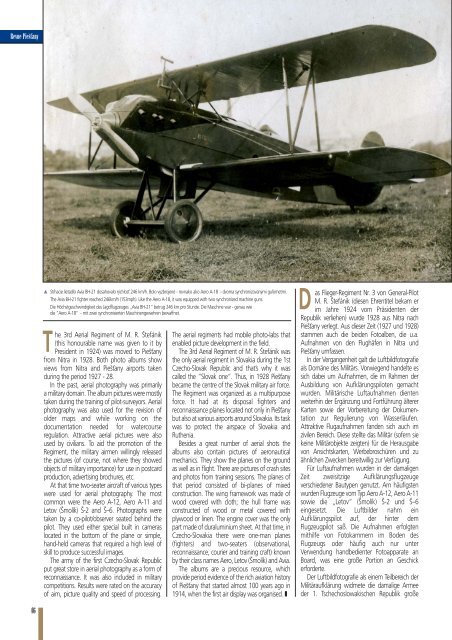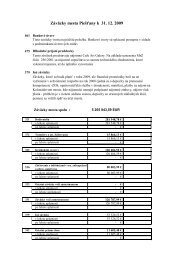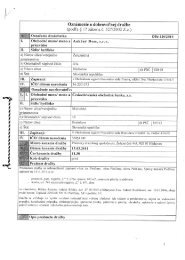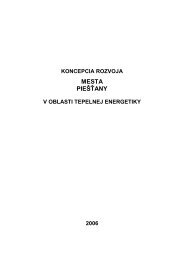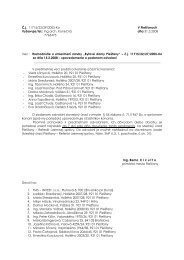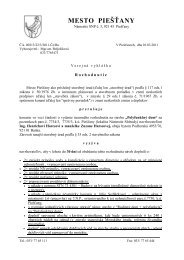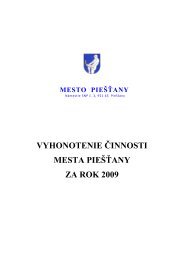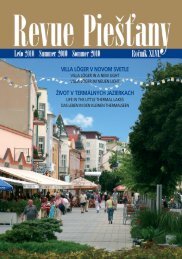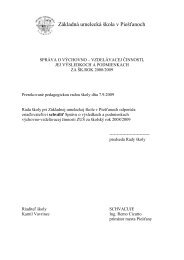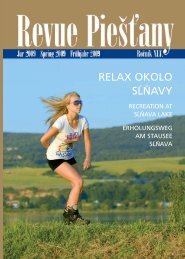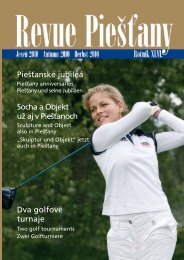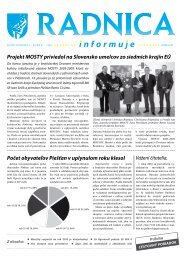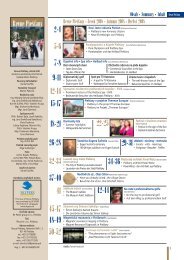Revue Piestany Jar 2011 - Piešťany
Revue Piestany Jar 2011 - Piešťany
Revue Piestany Jar 2011 - Piešťany
Erfolgreiche ePaper selbst erstellen
Machen Sie aus Ihren PDF Publikationen ein blätterbares Flipbook mit unserer einzigartigen Google optimierten e-Paper Software.
▲ Stíhacie lietadlo Avia BH-21 dosahovalo rýchlosť 246 km/h. Bolo vyzbrojené - rovnako ako Aero A-18 - dvoma synchronizovanými guľometmi.<br />
The Avia BH-21 fighter reached 246km/h (153mph). Like the Aero A-18, it was equipped with two synchronized machine guns.<br />
Die Höchstgeschwindigkeit des Jagdflugzeuges „Avia BH-21“ betrug 246 km pro Stunde. Die Maschine war - genau wie<br />
die “Aero A-18“ - mit zwei synchronisierten Maschinengewehren bewaffnet.<br />
The 3rd Aerial Regiment of M. R. Štefánik<br />
(this honourable name was given to it by<br />
President in 1924) was moved to Piešťany<br />
from Nitra in 1928. Both photo albums show<br />
views from Nitra and Piešťany airports taken<br />
during the period 1927 - 28.<br />
In the past, aerial photography was primarily<br />
a military domain. The album pictures were mostly<br />
taken during the training of pilot-surveyors. Aerial<br />
photography was also used for the revision of<br />
older maps and while working on the<br />
documentation needed for watercourse<br />
regulation. Attractive aerial pictures were also<br />
used by civilians. To aid the promotion of the<br />
Regiment, the military airmen willingly released<br />
the pictures (of course, not where they showed<br />
objects of military importance) for use in postcard<br />
production, advertising brochures, etc.<br />
At that time two-seater aircraft of various types<br />
were used for aerial photography. The most<br />
common were the Aero A-12, Aero A-11 and<br />
Letov (Šmolík) Š-2 and Š–6. Photographs were<br />
taken by a co-pilot/observer seated behind the<br />
pilot. They used either special built in cameras<br />
located in the bottom of the plane or simple,<br />
hand-held cameras that required a high level of<br />
skill to produce successful images.<br />
The army of the first Czecho-Slovak Republic<br />
put great store in aerial photography as a form of<br />
reconnaissance. It was also included in military<br />
competitions. Results were rated on the accuracy<br />
of aim, picture quality and speed of processing.<br />
The aerial regiments had mobile photo-labs that<br />
enabled picture development in the field.<br />
The 3rd Aerial Regiment of M. R. Štefánik was<br />
the only aerial regiment in Slovakia during the 1st<br />
Czecho-Slovak Republic and that’s why it was<br />
called the ”Slovak one“. Thus, in 1928 Piešťany<br />
became the centre of the Slovak military air force.<br />
The Regiment was organized as a multipurpose<br />
force. It had at its disposal fighters and<br />
reconnaissance planes located not only in Piešťany<br />
but also at various airports around Slovakia. Its task<br />
was to protect the airspace of Slovakia and<br />
Ruthenia.<br />
Besides a great number of aerial shots the<br />
albums also contain pictures of aeronautical<br />
mechanics. They show the planes on the ground<br />
as well as in flight. There are pictures of crash sites<br />
and photos from training sessions. The planes of<br />
that period consisted of bi-planes of mixed<br />
construction. The wing framework was made of<br />
wood covered with cloth; the hull frame was<br />
constructed of wood or metal covered with<br />
plywood or linen. The engine cover was the only<br />
part made of duraluminium sheet. At that time, in<br />
Czecho-Slovakia there were one-man planes<br />
(fighters) and two-seaters (observational,<br />
reconnaissance, courier and training craft) known<br />
by their class names Aero, Letov (Šmolík) and Avia.<br />
The albums are a precious resource, which<br />
provide period evidence of the rich aviation history<br />
of Piešťany that started almost 100 years ago in<br />
1914, when the first air display was organised. ❚<br />
D<br />
as Flieger-Regiment Nr. 3 von General-Pilot<br />
M. R. Štefánik (diesen Ehrentitel bekam er<br />
im Jahre 1924 vom Präsidenten der<br />
Republik verliehen) wurde 1928 aus Nitra nach<br />
Piešťany verlegt. Aus dieser Zeit (1927 und 1928)<br />
stammen auch die beiden Fotoalben, die u.a.<br />
Aufnahmen von den Flughäfen in Nitra und<br />
Piešťany umfassen.<br />
In der Vergangenheit galt die Luftbildfotografie<br />
als Domäne des Militärs. Vorwiegend handelte es<br />
sich dabei um Aufnahmen, die im Rahmen der<br />
Ausbildung von Aufklärungspiloten gemacht<br />
wurden. Militärische Luftaufnahmen dienten<br />
weiterhin der Ergänzung und Fortführung älterer<br />
Karten sowie der Vorbereitung der Dokumentation<br />
zur Regulierung von Wasserläufen.<br />
Attraktive Flugaufnahmen fanden sich auch im<br />
zivilen Bereich. Diese stellte das Militär (sofern sie<br />
keine Militärobjekte zeigten) für die Herausgabe<br />
von Ansichtskarten, Werbebroschüren und zu<br />
ähnlichen Zwecken bereitwillig zur Verfügung.<br />
Für Luftaufnahmen wurden in der damaligen<br />
Zeit zweisitzige Aufklärungsflugzeuge<br />
verschiedener Bautypen genutzt. Am häufigsten<br />
wurden Flugzeuge vom Typ Aero A-12, Aero A-11<br />
sowie die „Letov“ (Šmolík) Š-2 und Š–6<br />
eingesetzt. Die Luftbilder nahm ein<br />
Aufklärungspilot auf, der hinter dem<br />
Flugzeugpilot saß. Die Aufnahmen erfolgten<br />
mithilfe von Fotokammern im Boden des<br />
Flugzeugs oder häufig auch nur unter<br />
Verwendung handbedienter Fotoapparate an<br />
Board, was eine große Portion an Geschick<br />
erforderte.<br />
Der Luftbildfotografie als einem Teilbereich der<br />
Militäraufklärung widmete die damalige Armee<br />
der 1. Tschechoslowakischen Republik große<br />
46


